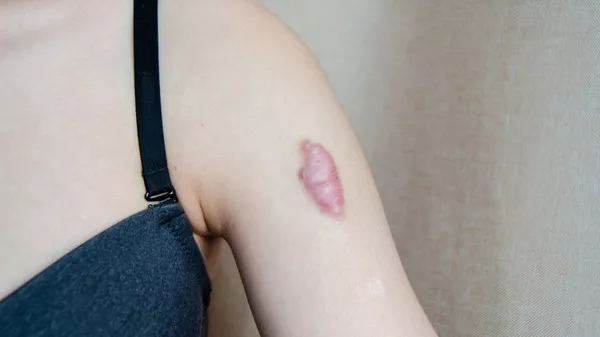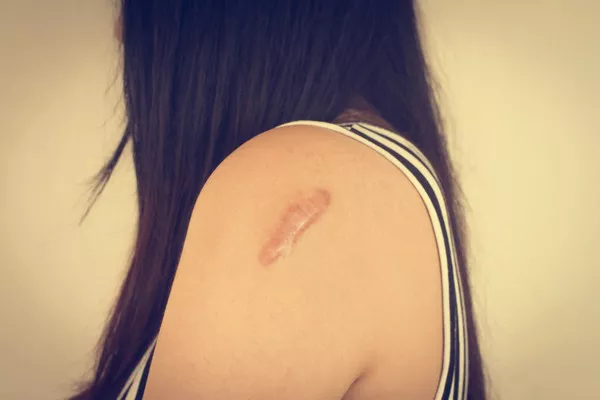Keloids are raised scars that form as a result of abnormal collagen production during the wound healing process. These scars can be bothersome and may cause aesthetic concerns or discomfort. Various treatment options are available to manage keloids, and natural remedies like vitamin E oil have been suggested as a potential solution. In this article, we will explore the effectiveness of vitamin E oil in treating keloids and examine the scientific evidence behind its use.
Understanding Keloids and the Healing Process
Keloids develop when the body produces excess collagen during the wound healing process. Unlike normal scars, keloids extend beyond the boundaries of the original wound and can continue to grow over time. Keloids are characterized by raised, thick, and often itchy or tender scar tissue.
The Healing Properties of Vitamin E
Vitamin E is a fat-soluble vitamin with antioxidant properties. It is known for its ability to neutralize harmful free radicals, which can cause oxidative damage to cells. Vitamin E also has anti-inflammatory effects and plays a role in promoting wound healing.
Antioxidant Effects
Vitamin E’s antioxidant properties help protect cells from damage caused by free radicals, which can impair the healing process. By reducing oxidative stress, vitamin E may support the body’s natural healing mechanisms and potentially improve the appearance and symptoms of keloids.
Anti-inflammatory Effects
Inflammation is a key factor in the development and progression of keloids. Vitamin E has been shown to possess anti-inflammatory properties that can help reduce redness, swelling, and discomfort associated with keloid scars. By modulating the inflammatory response, vitamin E may contribute to the overall improvement of keloid appearance.
Scientific Evidence
While vitamin E oil has been widely used as a home remedy for scar reduction, the scientific evidence regarding its effectiveness specifically for keloids is limited. Some studies have been conducted to explore the potential benefits of vitamin E for scar healing in general, but their findings are mixed.
A study published in the Journal of Plastic, Reconstructive & Aesthetic Surgery investigated the effects of topical vitamin E on postoperative scars. The study found that participants who applied vitamin E oil to their scars had no significant improvement in scar appearance compared to those who used a placebo.
Another study published in the Journal of Drugs in Dermatology examined the effects of a combination of silicone gel sheeting and vitamin E on hypertrophic scars and keloids. The results showed a reduction in scar thickness and color intensity in the group that used the combination treatment. However, it is important to note that the study did not specifically focus on vitamin E alone.
It is worth mentioning that some individuals may experience positive results with the use of vitamin E oil for keloids, while others may not see significant improvements. The effectiveness of vitamin E oil may vary depending on factors such as the individual’s skin type, the severity of the keloid, and the specific characteristics of the scar.
Practical Tips for Using Vitamin E Oil
If you decide to try vitamin E oil for keloids, consider the following tips:
Choose a High-Quality Product: Select a reputable brand of vitamin E oil or capsules. Look for products that contain pure vitamin E (alpha-tocopherol) without any added ingredients or fillers.
Patch Test: Before applying vitamin E oil to the entire keloid, conduct a patch test on a small area of skin to check for any potential allergic reactions or sensitivities.
Cleanse the Skin: Cleanse the keloid area with a gentle soap and warm water to remove any dirt or debris before applying the vitamin E oil. This will enhance its absorption and effectiveness.
Apply Regularly: Gently massage a small amount of vitamin E oil onto the keloid, ensuring complete coverage of the scar tissue. Repeat this process twice daily for several weeks or as directed by your healthcare provider.
Monitor Progress: Keep track of any changes in the appearance, size, or symptoms of the keloid while using vitamin E oil. Take photographs at regular intervals to assess the effectiveness of the treatment.
Consultation with a Healthcare Professional
While vitamin E oil is generally considered safe for topical use, it is essential to consult with a healthcare professional, such as a dermatologist, before starting any new treatment for keloids. They can evaluate the severity of the keloid and provide personalized recommendations based on your specific situation. They may also suggest other treatment options, such as silicone gel sheets, corticosteroid injections, or laser therapy, which have a stronger scientific evidence base for keloid management.
Conclusion
The effectiveness of vitamin E oil in treating keloids remains inconclusive based on the current scientific evidence. While some individuals may find it beneficial, others may not experience significant improvements. The antioxidant and anti-inflammatory properties of vitamin E suggest its potential role in supporting the healing process and reducing inflammation associated with keloids. However, it is important to approach vitamin E oil as a complementary treatment and consult with a healthcare professional for a comprehensive approach to keloid management. Individual results may vary, and a combination of treatment modalities may be necessary to achieve the best outcomes in keloid scar reduction.
[inline_related_posts title=”Related Topics” title_align=”left” style=”list” number=”3″ align=”none” ids=”454,447,457″ by=”categories” orderby=”rand” order=”DESC” hide_thumb=”no” thumb_right=”no” views=”no” date=”yes” grid_columns=”1″ post_type=”” tax=””]


































